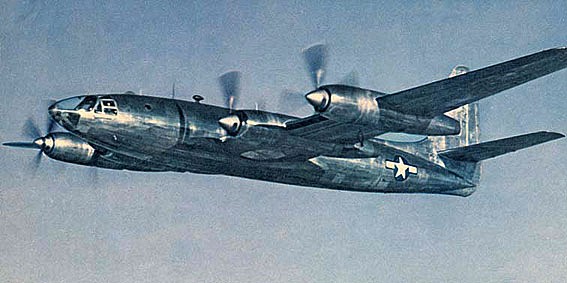Republic XF-12, 44-91002, first prototype, made its first flight on July 2, 1946. It was an extraordinary clean design, intended to be used as a long range strategic reconnaissance aircraft. Only two were built, as the AAF no longer needed the mission requirement.
Consolidated XB-36·CF, 42.13570, seen next to Boeing B·29B·55·BA, 44-84027, shows the huge size of the new aircraft.
1945 opened with a massive surprise attack by the Luftwaffe on Allied airfields in Belgium. However, when the attack was over, the Luftwaffe had suffered huge losses in aircraft and pilots, while the Allies were able to replace all of their aircraft in a week, and lost only a few pilots. This broke the back of the Luftwaffe and from then on, the AAF were able to carry out ever increasing attacks on German industry as the country’s borders shrank under the Allies massive ground attacks. The end of the war in Europe came after only a few months and VB-Day was celebrated on May 8, 1945.
After catching its breath, the AAF turned to its final war effort, the defeat of Japan. The Twentieth Air Force had been formed in April 1944 and in the summer of that year had started heavy bomber operations against Japan, Formosa, Thailand, and Burma. At the beginning of 1945, the Far East Air Force (FEAF) was attacking the Philippines and Borneo. The Seventh, Tenth, Eleventh, and Fourteenth Air Forces were chasing the Japanese in the Asia and Pacific theaters, moving closer and closer to the Japanese homeland. The end for Japan came in August, when two atomic bombs proved that Japan could be defeated without an invasion.
Even though the war only continued for just over four months against Germany, aircraft losses continued to be heavy, 3,631 aircraft being lost in the European and Mediterranean theaters. This brought the total losses in the war against the Axis powers in Europe to no less than 18,418 aircraft. In the Pacific area in the war against Japan, some 1,699 aircraft were lost, bringing the total in that area to 4, 530 aircraft. This included 399 lost by the new Twentieth Air Force, primarily B-29s. Fighting the greatest war in world history had cost the USAAF some 22,948 aircraft and total casualties of 121,867 personnel.
At mid-1945, the USAAF strength had declined in total number of aircraft, to 68,398, but this was somewhat misleading: all combat types of aircraft had actually increased, the decrease being chiefly in a drop of training aircraft from the previous 27,907 to some 12,581. Very heavy bombers, mainly the B-29 plus a few B-32s, had grown to no less than 2,374 aircraft.
Once victory had been gained, the United States demobilized headlong, just as it had done at the end of World War I. Hundreds of aircraft were scrapped or sold, the strength having dropped to 44,782 aircraft by December 1945, and bases world-wide were closed. So many men were demobilized that the AAF could only muster two groups ready for combat by July 1946. A totally new Air Force had to be built for peacetime operations; its authorized strength was 70 groups but peacetime budgets kept it to only 48 groups (in fact, the reduction in the number of aircraft was such that when the next war broke out in Korea, there were only 19,944 on strength in June 1951).
As a result, the amount of time and effort spent on specs. and T. O. s was extremely small compared to the very active war years, as we shall see. However, the Army Air Forces commanders had never lost sight of their aim to become a separate service, on a level with the Army and Navy. Planning for this had started in 1943 and was well advanced by mid-1945. Eventually, all of this came to fruition in 1947, but not until after meeting with strong opposition from the Navy.
During this immediate post-war period, the AAF also began to receive the first of its jet-propelled aircraft, and put some of them into unit service. The Lockheed P-80 was the first to enter service, to be followed somewhat later by the Republic P-84. The first of the giant inter-continental bombers in the form of the competing Northrop XB-35 and the Convair XB-36 also made their first flights, as did the North American B-45 and Convair B-46 four-jet light and medium bombers. However, the transport field was still dominated by piston-engined types, such as the Douglas C-74 and the Fairchild C-82. It was a period of transition to new technologies, and opened up the future to the sharply reduced AAF.
